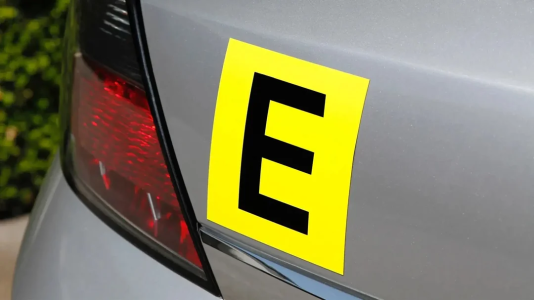Driving the point home: Aussie state’s licence rule leaves drivers scratching their heads
- Replies 0
Navigating the roads can be a complex affair, with various signs, signals, and regulations to keep in mind.
However, for drivers in one Aussie state, there's an additional layer of complexity that has left many across the nation scratching their heads in bewilderment.
The topic of confusion? A unique licensing system that requires certain drivers to display ‘E-plates’ on their vehicles—a rule that has sparked debate and even calls for its abolishment.
The ‘E’ in E-plates stands for ‘extraordinary’, and these plates are indeed out of the ordinary for most Australian drivers.
Most people are familiar with the standard L and P plates, which indicate to other drivers who are still learning to drive.
However, many outside Western Australia may not be aware of the unique Extraordinary Licence (EL).

While licence types differ across regions, including those for heavy machinery, foreign nationals, and motorcyclists, E-plates are a Western Australian peculiarity.
They are designated for drivers who have had their standard licence disqualified but are granted permission to drive under strict conditions, such as for essential medical appointments or to maintain employment.
A representative from the Western Australian Department of Transport (DOT) stated that although the number of Extraordinary Licences (ELs) issued has declined over the past three years, there are still hundreds of them in use on the roads today.
During the 2023-24 financial year, a total of 424 six-month Extraordinary Licences (ELs) and 408 one-year ELs were issued to drivers in Western Australia.
In comparison, the 2022-23 financial year saw 583 six-month ELs and 579 one-year ELs approved, showing a slight decrease from the previous year.
The concept of an extraordinary licence (EL) may seem foreign to many Aussies outside of WA, and it's not without its critics.
After Perth-based podcasters Jamison Lennon and Dylan Saccomanno brought the issue to light on social media, describing the system as ‘embarrassing’, the public response ranged from surprise to outright disapproval.
Some Australians expressed their disbelief. One commenter wrote, ‘E-plates shouldn't exist.’
‘Only WA has E-plates,’ another added. ‘It’s ridiculous, [because] no other court conviction can someone go, “Aw no, court, can you pretty please not make my license disqualified.”’
‘E-plates are just L-plates that have two bits of tape across the L,’ a third remarked.
The Western Australian Department of Transport (DOT) has outlined that obtaining an EL is no simple feat.
Applicants must navigate a rigorous set of requirements, with the most notable being a prohibition on those disqualified for alcohol-related offences.
‘An extraordinary licence will only be issued if a Court considers it appropriate for a driver to be issued with one,’ a spokesperson explained.
‘Wait periods prior to lodging an application for an extraordinary licence also apply, determined by the number and nature of the offence or offences.’
‘When a disqualified driver seeks a court order for the CEO Department of Transport to grant an extraordinary licence, the Department of Transport legal representatives will test the veracity of the evidence and submissions made to ensure they meet the requirements of the legislation,’ they added.
Drivers who have had their licence suspended due to a demerit point accumulation, an immediate disqualification notice, a fine suspension, or those who have had an extraordinary licence application rejected by a court in the last six months are ineligible to apply.
Several online sources indicated that it is the responsibility of the individual to obtain their own E-plates, with many social media users claiming they were instructed to make their own.
Some reports suggest that EL holders should ‘customise traditional L-plates’ to create ‘E-plates’.
When asked for official guidance on the matter, the spokesperson did not provide a direct answer but stated, ‘Should the display of an E-plate be a condition of an extraordinary licence being issued, it is the responsibility of the licence holder to arrange it.’
While the confusion surrounding Western Australia's extraordinary licence (EL) plates has left many drivers scratching their heads, it's not the only time licence plates have sparked curiosity.
From quirky personal messages to those that may hold deeper meanings, license plates often serve as more than just a simple identifier on the road.
In fact, some have even used their plates to convey subtle or not-so-subtle messages to others.
Let’s take a closer look at the fascinating world of licence plates and what they can reveal, from humorous statements to serious conversations.
 As we delve into this peculiar aspect of Western Australian road law, we invite our readers to share their thoughts and experiences. Have you encountered E-plates on your travels, or do you have an opinion on their necessity? Should there be a more standardised approach to such licences across Australia, or is the flexibility to accommodate individual circumstances paramount? Join the discussion in the comments below and let us know what you think about the extraordinary case of the E-plates.
As we delve into this peculiar aspect of Western Australian road law, we invite our readers to share their thoughts and experiences. Have you encountered E-plates on your travels, or do you have an opinion on their necessity? Should there be a more standardised approach to such licences across Australia, or is the flexibility to accommodate individual circumstances paramount? Join the discussion in the comments below and let us know what you think about the extraordinary case of the E-plates.
However, for drivers in one Aussie state, there's an additional layer of complexity that has left many across the nation scratching their heads in bewilderment.
The topic of confusion? A unique licensing system that requires certain drivers to display ‘E-plates’ on their vehicles—a rule that has sparked debate and even calls for its abolishment.
The ‘E’ in E-plates stands for ‘extraordinary’, and these plates are indeed out of the ordinary for most Australian drivers.
Most people are familiar with the standard L and P plates, which indicate to other drivers who are still learning to drive.
However, many outside Western Australia may not be aware of the unique Extraordinary Licence (EL).

Australians were confused by Western Australia's ‘extraordinary licence’ (EL) system. Credit: Reddit / r/CarsAustralia
While licence types differ across regions, including those for heavy machinery, foreign nationals, and motorcyclists, E-plates are a Western Australian peculiarity.
They are designated for drivers who have had their standard licence disqualified but are granted permission to drive under strict conditions, such as for essential medical appointments or to maintain employment.
A representative from the Western Australian Department of Transport (DOT) stated that although the number of Extraordinary Licences (ELs) issued has declined over the past three years, there are still hundreds of them in use on the roads today.
During the 2023-24 financial year, a total of 424 six-month Extraordinary Licences (ELs) and 408 one-year ELs were issued to drivers in Western Australia.
In comparison, the 2022-23 financial year saw 583 six-month ELs and 579 one-year ELs approved, showing a slight decrease from the previous year.
The concept of an extraordinary licence (EL) may seem foreign to many Aussies outside of WA, and it's not without its critics.
After Perth-based podcasters Jamison Lennon and Dylan Saccomanno brought the issue to light on social media, describing the system as ‘embarrassing’, the public response ranged from surprise to outright disapproval.
Some Australians expressed their disbelief. One commenter wrote, ‘E-plates shouldn't exist.’
‘Only WA has E-plates,’ another added. ‘It’s ridiculous, [because] no other court conviction can someone go, “Aw no, court, can you pretty please not make my license disqualified.”’
‘E-plates are just L-plates that have two bits of tape across the L,’ a third remarked.
The Western Australian Department of Transport (DOT) has outlined that obtaining an EL is no simple feat.
Applicants must navigate a rigorous set of requirements, with the most notable being a prohibition on those disqualified for alcohol-related offences.
‘An extraordinary licence will only be issued if a Court considers it appropriate for a driver to be issued with one,’ a spokesperson explained.
‘Wait periods prior to lodging an application for an extraordinary licence also apply, determined by the number and nature of the offence or offences.’
‘When a disqualified driver seeks a court order for the CEO Department of Transport to grant an extraordinary licence, the Department of Transport legal representatives will test the veracity of the evidence and submissions made to ensure they meet the requirements of the legislation,’ they added.
Drivers who have had their licence suspended due to a demerit point accumulation, an immediate disqualification notice, a fine suspension, or those who have had an extraordinary licence application rejected by a court in the last six months are ineligible to apply.
Several online sources indicated that it is the responsibility of the individual to obtain their own E-plates, with many social media users claiming they were instructed to make their own.
Some reports suggest that EL holders should ‘customise traditional L-plates’ to create ‘E-plates’.
When asked for official guidance on the matter, the spokesperson did not provide a direct answer but stated, ‘Should the display of an E-plate be a condition of an extraordinary licence being issued, it is the responsibility of the licence holder to arrange it.’
While the confusion surrounding Western Australia's extraordinary licence (EL) plates has left many drivers scratching their heads, it's not the only time licence plates have sparked curiosity.
From quirky personal messages to those that may hold deeper meanings, license plates often serve as more than just a simple identifier on the road.
In fact, some have even used their plates to convey subtle or not-so-subtle messages to others.
Let’s take a closer look at the fascinating world of licence plates and what they can reveal, from humorous statements to serious conversations.
Key Takeaways
- There was confusion among Australians regarding the ‘extraordinary licence’ (EL) system in Western Australia, which requires drivers with a disqualified licence to display E-plates for critical reasons.
- The number of extraordinary licences issued has declined in the last three years, with 424 six-month ELs and 408 one-year ELs issued in the 2023-24 financial year.
- To obtain an EL, drivers must meet a strict set of criteria, including not being disqualified for alcohol-related offences, and the licence will only be issued if a Court deems it appropriate.
- Drivers who are granted an EL are responsible for arranging the display of their E-plates, which can involve customising traditional L-plates.







